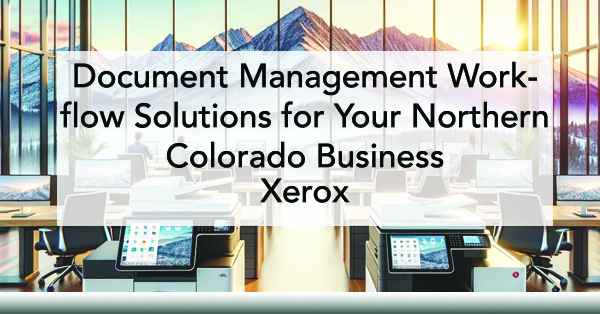
How To Optimize Your Business with Digital Document Management
Did you know that Automated Business Technologies (ABT) offers a comprehensive range of digital document management solutions designed to streamline business operations, reduce costs, and enhance productivity? Transitioning from paper-based to digital systems is crucial for businesses aiming to stay competitive in today’s fast-paced environment.
We wanted to take an in-depth look at the benefits of digital document management and how ABT can help you implement it successfully so you can improve your overall bottom line.
The Critical Need for Digital Document Management
Efficiency and speed are paramount for your Denver business, relying on traditional paper-based systems can severely hinder your business’s ability to compete (not to mention the stress on your team!) Paper documents are not only cumbersome and time-consuming to manage but also vulnerable to loss, damage, and unauthorized access. By adopting a digital document management system (DMS), your organization can enjoy streamlined workflows, enhanced security, and improved regulatory compliance.
Key Advantages of Digital Document Management
- Accessibility and Collaboration: Digital documents are accessible from any location at any time, which is essential for remote work and team collaboration.
- Enhanced Security: DMS offers robust security features, including encryption, access controls, and detailed audit trails to protect sensitive information.
- Cost Savings: Transitioning to a digital system can significantly reduce costs associated with physical storage, printing, and manual document handling.
- Regulatory Compliance: A well-implemented DMS helps businesses adhere to industry regulations by automating retention schedules and maintaining thorough audit trails.
- Disaster Recovery: Digital documents are easier to back up and protect, ensuring your critical information is never lost.
6 Steps to Implementing a Digital Document Management System
Implementing a DMS may seem overwhelming, but with careful planning, it can be a smooth and beneficial process. Below are the essential steps to get you started:
1. Evaluate Your Current Document Management System
Begin by assessing your current document management practices. Identify inefficiencies such as time-consuming retrieval processes, frequent document misplacements, and security issues. This evaluation will help you understand what features your new DMS needs.
2. Choose the Right Software
Selecting the appropriate DMS software is crucial to your success. The software should be scalable, user-friendly, and capable of integrating with your existing systems. Key features to look for include:
- Automated Workflow Management: Automate tasks like document routing, approval processes, and notifications.
- Advanced Search Capabilities: Ensure the software provides powerful search features based on keywords, tags, or metadata.
- System Integration: The DMS should integrate seamlessly with other tools you use, such as CRMs and accounting software.

3. Digitize Your Paper Documents
The next step is to convert your paper documents into digital formats. Start with the most critical documents and gradually work through your archives. If the volume of documents is large, consider outsourcing this task to a professional service.
UniFlow is a powerful tool that enhances digital document management by offering advanced print and scan management solutions. It integrates seamlessly with your existing systems, allowing you to control and optimize document workflows from a central platform.
With features like secure printing, user authentication, and comprehensive tracking, UniFlow helps businesses reduce costs, increase security, and improve efficiency. By automating routine tasks and providing detailed analytics, UniFlow ensures that your document management processes are streamlined and aligned with your organization’s goals.
4. Index and Add Metadata
Proper indexing and the addition of metadata are critical for easy document retrieval. Assign categories, keywords, and other relevant information to each document to ensure your DMS is efficient and user-friendly.
5. Train Your Team
Training is a key component of a successful DMS implementation. Provide comprehensive training sessions for your team to familiarize them with the new system. Regular refresher courses can help reinforce new processes and ensure consistent use.
6. Monitor and Improve
After implementation, continuously monitor the system’s performance and gather user feedback. Use this information to make necessary adjustments and improvements.
Best Practices for Effective Digital Document Management
To ensure your digital document management system is effective, follow these best practices:
- Regular Updates and Maintenance: Keep your DMS up to date with the latest features and security patches.
- Version Control: Implement version control to track document changes and allow for easy reversion if needed.
- Access Control: Set up role-based access controls to protect sensitive documents.
- Digital-First Approach: Encourage the use of digital processes over paper-based ones by promoting e-forms and digital signatures.
Transitioning to a digital document management system offers numerous benefits, from increased efficiency and security to significant cost savings and improved compliance. Automated Business Technologies (ABT) is here to help businesses in Colorado successfully implement and optimize their digital document management systems. With tailored solutions and expert support, ABT ensures your transition is smooth and your operations are future-ready.
Ready to embrace digital document management? Contact ABT today to learn how they can assist with your digital transformation journey.

